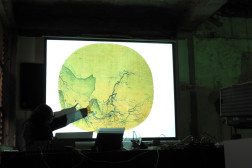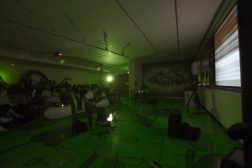


Shanghai Futurism II: Inner Noise from New Asia
Time: April 15th, 8:oo pm at Yuyintang
Location: 731 Yan’an Xi Lu, Changning
Entrance at Kaixuan Lu
Following the success of the musical collaborations that ensued Christian Marclay’s Screenplay, Arthub has invited Yan Jun to curate an evening of noise in Shanghai. The program titled “Inner Noise from New Asia” will use Luigi Russolo’s Futurist manifesto, “The Art of Noises,” as a historical reference point and feature new work by contemporary performers from different parts of Asia, to provide a full spectrum of experience of this eclectic genre of music.
“Inner Noise from New Asia” features live performances by Otomo Yoshihide, Sachiko M, FEN and Shanghai’s Asthma Writers Union, and MTDM; the event is organized by Sub Jam, in association with RESO, and in collaboration with Performa 09.
Reflections from Sub Jam on the contrasting influence and power of noise and music.
To human beings, the history of listening to noise is much longer than that of enjoying music. Noise accompanies life. And in this vast universe, there are plenty of noises which cannot be sensed by human beings. Western civilization developed a perfect music system. As a universe built by man itself, polyphony owns a developed order, like that in science and politics. But reason is not always the rule.
Italian futurists said one hundred years ago, “Let’s break through the obnoxious shield of reason.” Several years later, Luigi Russolo published “The Art of Noises” and began creating music with everyday noises. In 1952, John Cage guided people hearing silence with 4’33’’, and in 1966, Max Neuhuas led people to pass through the downtown area, hearing the sound of the streets. In ancient Eastern Asia, people hold a tradition hearing the sounds in nature because they believe that harmony should be reached between music, art and nature, and the inner and outer world. They thought the sound of wind, rain and dripping, shared the same value to appreciate as music and all of them had an inner connection.
People have accepted the influence of the Western civilization in order to pursue modernization in contemporary times. Conflicts and combination happen all the time between reason and perception, technology and custom. The noises of life change with the life itself and become something more strange, for example, the forming of the sound in urbanology from the reflection of the firecrackers during Spring Festival in the buildings. When entering the 21st century, people realized that noise is the reflection of the real world, and thus, stopped arguing about it. The listening to and creation of noise, are derived from that to, and of, the music, it has reached where the music cannot reach, no matter whether it is the sensation and description of the outer world or the understanding of the inner one.
Participating Artists and Organizations
Yan Jun, is Beijing based sound artist and poet, as well as a music critic and organizer. Yan’s live performances engages space feedback, loop and voice/language to make hypnotic noise. He also uses concepts of recycling, feedback and reduction to create sound art work, which relates to field recording, installation, image, video, publishing and multiple forms. He has performed and participated in exhibitions internationally.
Otomo Yoshihide is one of the most acclaimed international experimental musicians. He is a guitarist, turntablist, electronics player and film music composer. He has also been active in the jazz music field. With numerable releases and concerts around the world, he has gained great honor in the contemporary music world.
FEN (Far East Network) is a totally new project by Otomo Yoshihide. Musicians of a similar kind, who live in big cities in East Asia such as Tokyo, Beijing, Singapore and Seoul, have had few opportunities to come together. However, for several years now in the age of internet, they have had a chance to get to know each other for the first time and now realize that they are able to play together, though there is not always a place where they can meet. “MIMI Festival,” is an experimental music festival held annually in Marseille, that has provided them with an unexpected opportunity. In July this year, they will perform there after spending several days rehearsing in Marseille. They themselves have no idea what will be produced. What FEN aims to do, is to not produce an expected kind of music, but to naturally develop such that a network such as themselves is capable of producing. Then you will see, with the start of this project, how musicians who have seldom met together, living in different cities, will develop their network, what they are capable of producing, and what we can find out through their performance.
Sachiko M has been active as a sampler player since 1994. In 1998, in a drastic departure from her previous approaches, she originated the revolutionary method she uses to this day–manipulating the sampler’s internal test tones. With the 2000 release of Sine Wave Solo, her extreme solo recording consisted entirely of sine waves, Sachiko M suddenly became the focus of intense interest on the international scene. Sachiko M was awarded the Ars Electronica 2003 Golden Nica prize in the digital music category. Her latest solo CD “Salon de Sachiko,” includes the sound installation “I’m Here.”
Filament (Otomo Yoshihide and Sachiko M) was formed in 1997. This unit was a product of the endless and thorough analyses and examinations of listening and pronunciation, as a testing ground for post-electronics music. With Sachiko M’s original composition method as a core, it brings about sound experience that is totally different from music made by conventional “composition” or “improvisation,” going beyond the auditory limits ranging from faint to roaring sound. So far, they’ve performed in more than ten countries in the world and their performances often spark arguments and dialogue about conventional audio techniques, as opposed to those newly developed by Filament and others.
Yuen Chee Wai’s work explores how image, sound and text can occur spontaneously as a symbiotic mental production. Informed by philosophical interests, his explorations with noise is process-oriented as much as it sculpts both personal and public experiential terrains. Known for his drone/ambient/field recording approaches and live performances, the photographic elements in his installations reflect also on the theme of sound and silence as a visual lens. In encountering the objects and architecture of a surrounding soundscape, imprints of images recur on the mind’s eye, almost as if in stasis. Visual/verbal patterns or perimeters, their time sequences and frequencies become collapsible around memory, even the very attempt to recall a lost, unnamed, undeterminable subject. This thematic form of speech and silence is often communicated through the conceptual structure and time-based orientation of his performances, where sound as a medium offers up a shifting vacancy, a fleeting space of invisibility in which images, along with resistive moments of distortion and clarity, dense signals and thinning messages clash and collide, then quiet down, decay and are gone.
Ryu Hankil was born in 1975 in Seoul, South Korea. He was a keyboard player in two famous Korean indie pop groups, but eventually left the groups because he was tired of typical music making and sounds. At that time, he saw a concert by Otomo Yoshihide, Sachiko M, Axel Dörner and Taku Unami in Seoul. He changed his musical instrument and concentrated on improvised music and sound related works. Hankil has organised a monthly concert series called Relay since 2005. He established his own publishing office called Manual, and releases improvised music and magazines.
MTDM, means “horse without legs” literally in Chinese. The band was founded in 2005 in Duesseldorf, Germany, by 2 young artists, who commited themselves to the freedom of music and a pure spontaneous sound. Similar to the Fluxus predecessors’ exploration into the cross-border arts, the practice of MTDM can be considered a tribute to the pioneers. MTDM seems to be synonymous with “good-for-nothing;” in almost all Western films, if a horse breaks its legs, it will be killed by the cowboys with no exception. The 2 members, Jun-Yuan and Yi Tao, were both born in the year of horse (in 1978). “Horse without legs,” is a self-mocking name, which implies the profound thinking of the 2 artists about how to walk without legs.
Jun-Yuan Zhao: reeds, prepared instrument, object
Yi Tao: percussion, object
Asthma Writers Union comes from Shanghai, China; the only member is Mai Mai. The artist has been extremely influenced by noise and improvisational artists like Derek Baily and Fred Frith. Mai Mai began to explore free style improvisation after a shoegaze and dream-pop based album was released by Miniless recordings. Although he is the core member of Muscle Snog, his sound in Asthma Writers Union is hugely differently from the band’s. Most of the sound comes from the guitar itself with little or no renderings of guitar effects by the help of different gadgets, tools or objects. Moreover, these sounds are very sensitive, dramatic and variable–they could suddenly change from a kind of subtle and delicate drone into an enormous and violent wave. He is also founder and director of a local organization called RESO (Reconstruct the Experimental Soundscape of Ourselves) which has held three live improvisational performance including artists from the US, the UK, Germany and China.




